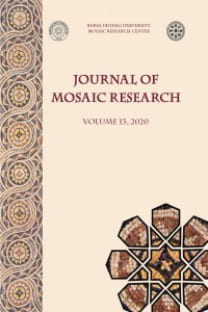Tryphe ve Bios Mozaiği’nin İkonografik ve İkonolojik Açıdan Değerlendirilmesi
Iconographic and Iconological Evaluation of the Tryphe and Bios Mosaic
___
- Balty 2009a J. Ch. Balty, “Bios”, LIMC III.1, 116-117.
- Balty 2009b J. Ch. Balty, “Tryphe”, LIMC VIII.1, 96-97.
- Boriello et al. 1986 M. R. Borriello - M. Lista - U. Pappalardo - V. Sampaolo - C. Ziviello, Le collezioni del Museo nazionale di Napoli: I mosaici, le pitture, gli oggetti di uso quotidiano, gli argenti, le terrecotte invetriate, i vetri, i cristalli, gli avori, Roma, De Luca.
- Burns 1995 R. Burns, Monuments of Syria: An Historical Guide, London, New York.
- Campbell 1988 S. Campbell, The Mosaics of Antioch, Toronto.
- Dunbabin 2002 K. M. D. Dunbabin, Mosaics of the Greek and Roman World, Cambridge.
- Erten 2016 E. Erten, “Olba 2015 Kazılarından Yeni Bir Buluntu: Roma Mozaiği”, Seleucia 6, 50-91.
- Faust 1989 S. Faust, Fulcra: Figürlicher und ornamentaler Schmuck an antiken Betten, Mitteilungen des Deutschen Archäologischen Instituts, Römische Abteilung, Mainz.
- Hornum 1993 M. B. Hornum, Nemesis, the Roman State and the Games, Leiden, New York.
- Huskinson 2003 J. Huskinson, “Theatre, Performance and Theatricality in Some Mosaic Pavements From Antioch”, BICS 46, 131-165.
- Kondoleon 2000 C. Kondoleon, Antioch: The Lost Ancient City, Princeton, N.J.: Worcester, MA.
- Lapatin 2015 K. D. S. Lapatin, Luxus: The Sumptuous Arts of Greece and Rome, Los Angeles.
- Leipen 1969 N. Leipen, “A New Mosaic in the Royal Ontario Museum”, Archaeology 22, 3, 231-231.
- Levi 1947 D. Levi, Antioch Mosaic Pavements, Vol.I-II, Princeton.
- Özgan 2015 R. Özgan, Roma Portre Sanatı III, İstanbul.
- Pedone 2012 S. Pedone, “The Jewels in the Mosaics of Antioch. Some Visual Examples of Late Antique and Byzantine Luxury”, RSO 85, 1/4, 391-410.
- Richter 1966 G. M. A. Richter, The Furniture of the Greeks, Etruscans and Romans, London.
- Riefstahl 1956 E. Riefstahl, “Nemesis and the Wheel of Fate”, Brooklyn Museum Bulletin 17, 3, 1-7.
- Robinson 1934 D. M. Robinson, “The Villa of Good Fortune at Olynthos”, AJA 38, 4, 501-510.
- Tondriau 1948 J. Tondriau, “La Tryphé, philosophie royale ptolémaïque”, REA 50, 1-2, 49-54.
- Tülek 2011 F. Tülek, “The Bejewelled Lady of Sinope”, M. Şahin (ed.), 11th International Colloquium on Ancient Mosaics, Bursa, 921-926.
- Young 1965 R. S. Young, “Early Mosaics at Gordion”, Expedition 7, 4-13.
- Young 2003 G. K. Young, “Emesa and Baalbek: Where is the Temple of Elahagabal?”, Levant 35, 1, 159-162.
- ISSN: 1309-047X
- Yayın Aralığı: 1
- Başlangıç: 2008
- Yayıncı: Ululdağ Üniversitesi, Mozaik Araştırlmaları Merkezi
Cristina COCCIA, Ilaria Marta CARRA, Maria Benedetta GANDINI, Paola PERPIGNANI, Simone ZAMBRUNO
Ashdod Maritima, İsrail’de Yeni Keşfedilen Dini Kompleksin Mozaik Zeminlerindeki İnanç Sembolleri
Bezemelerin Simetrilerinde Saklı Olan Ortaçağ Kültür İlişkileri
Sırrı ÇÖLMEKÇİ, Emrah KAHRAMAN, Emir SON
Matematik Teoremlerinin Antik Dönem Mozaikleri Üzerinde Tespiti
Paola PERPIGNANI, Paolo RACAGNI
Bathonea’dan Erken Hristiyanlık Dönemine Ait Bir Martyrion ve Opus Sectile Döşemesi
Batuhan SAZAK, Şengül AYDINGÜN, Haldun AYDINGÜN
Nil Nehri’nin Mozaiklerdeki Temsili: Çeşitli Bağlamlar, Çeşitli Anlamlar
Kuzey Suriye’deki Hierapolis’te (Münbiç) Keşfedilen Dionysos Mozaiği
